
The Robb House, located at 23 Park Avenue on the corner of East 35th Street in the Murray Hill neighborhood of Manhattan, New York City is a townhouse built in 1888-92 and designed in the Italian Renaissance revival style by McKim, Mead & White, with Stanford White as the partner-in-charge.

The Dyckman House, now the Dyckman Farmhouse Museum, is the oldest remaining farmhouse on Manhattan island, a vestige of New York City's rural past. The Dutch Colonial-style farmhouse was built by William Dyckman, c.1785, and was originally part of over 250 acres (100 ha) of farmland owned by the family. It is now located in a small park at the corner of Broadway and 204th Street in Inwood, Manhattan.

75 Murray Street, also known as the Hopkins Store, is a historic building between West Broadway and Greenwich Street in the TriBeCa neighborhood of Manhattan, New York City. It was built in 1857-58 and features a cast-iron facade in the Venetian Renaissance style from the foundry of James Bogardus, one of the earliest of the few remaining facades created by the self-described inventor of cast-iron architecture.

203 Prince Street is an historic townhouse on Prince Street between MacDougal and Sullivan Streets in the SoHo neighborhood of Lower Manhattan, New York City. Built in 1834 with 2+1⁄2 stories on land that was once part of the estate of Aaron Burr, the house acquired an additional full story in 1888. Primarily constructed in the late Federal style, the building also has elements of the Greek Revival style.

The John Street United Methodist Church – also known as Old John Street Methodist Episcopal Church – located at 44 John Street between Nassau and William Streets in the Financial District of Manhattan, New York City was built in 1841 in the Georgian style, with the design attributed to William Hurry and/or Philip Embury. The congregation is the oldest Methodist congregation in North America, founded on October 12, 1766 as the Wesleyan Society in America.

254–260 Canal Street, also known as the Bruce Building, is a building on the corner of Lafayette Street in the Chinatown neighborhood of Manhattan, New York City. It was constructed in 1856–57 and designed in the Italian Renaissance revival style. The cast-iron elements of the facade may have been provided by James Bogardus, a pioneer in the use of cast iron in architecture. The building was constructed for George Bruce, a prosperous printer and inventor of new technologies in the printing industry, which was then one of New York's leading industries. It was converted to offices in 1987 by architect Jack L. Gordon.
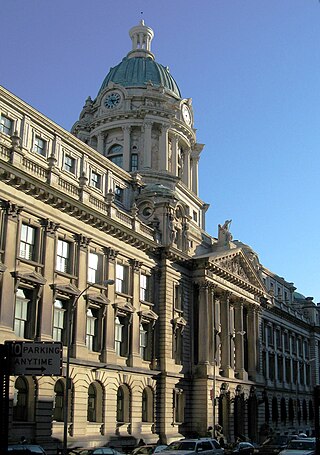
240 Centre Street, formerly the New York City Police Headquarters, is a building between Broome and Grand Streets in the Little Italy neighborhood of Manhattan, New York City.

The Robbins & Appleton Building is a historic building at 1–5 Bond Street between Broadway and Lafayette Street in the NoHo neighborhood of Manhattan in New York City. Built in 1879–1880, it was designed by architect Stephen Decatur Hatch in the Second Empire style. The building features an ornate cast iron facade and mansard roof; it was originally used for the manufacture of watch cases and by publisher D. Appleton & Company. It was converted in 1986 to residential use. The building next door, at 7-9 Bond Street, is an inferior imitation of its neighbor.
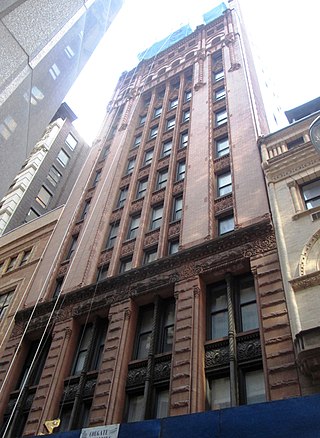
56 Pine Street – originally known as the Wallace Building after its developer, James Wallace – at 56-58 Pine Street between Pearl and William Streets in the Financial District of Manhattan, New York City, was built in 1893-94 and was designed by Oscar Wirz in the Romanesque Revival style.

Firehouse, Engine Company 31 is a historic fire station located at 87 Lafayette Street between Walker and White Streets in the Civic Center neighborhood of Manhattan, New York City. It was built in 1895 and designed by architects Napoleon LeBrun & Sons, who styled it after an early-16th-century chateau in the Loire Valley of France.
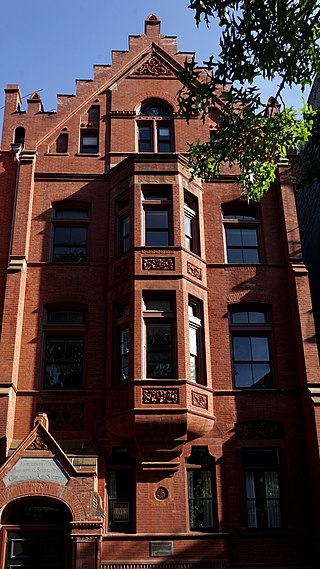
The Fourteenth Ward Industrial School is located at 256-258 Mott Street between Prince and Houston Streets in the Nolita neighborhood of Manhattan, New York City. It was built for the Children's Aid Society in 1888–89, with funds provided by John Jacob Astor III, and was designed by the firm of Vaux & Radford in the Victorian Gothic style. The Society built a number of schools for indigent children at the time. It was later known as the Astor Memorial School.

The Schermerhorn Row Block, located at #2 through #18 Fulton Street in the Financial District of Manhattan, New York City, was constructed in 1811–12 in the Federal style, and is now part of the South Street Seaport. Each of the individual houses were designated New York City Landmarks in 1968, and the block was collectively added to the National Register of Historic Places in 1971.

The New York County Lawyers' Association Building is a structure at 14 Vesey Street between Broadway and Church Street in the Financial District of Manhattan, New York City. It was built in 1929–30 and was designed by architect Cass Gilbert in the English Georgian style for the Association, which was founded in 1908. Gilbert's design complements Trinity Church's St. Paul's Chapel, which sits across the street.

The Edward Mooney House is a building at 18 Bowery, at the corner of Pell Street, in the Chinatown neighborhood of Manhattan, New York City. It was built between 1785 and 1789 for wealthy butcher Edward Mooney on land he purchased after it was confiscated from British Loyalist James De Lancey.

The Grand Hotel is located at 1232–1238 Broadway at the corner of West 31st Street in the NoMad neighborhood of Manhattan, New York City.
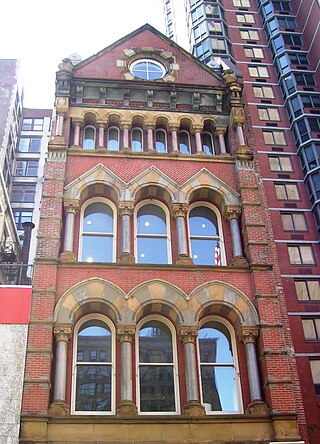
The David S. Brown Store at 8 Thomas Street between Broadway and Church Street in the TriBeCa neighborhood of Manhattan, New York City was built in 1875-76 for a soap manufacturer. It was designed by J. Morgan Slade in the Victorian Gothic style, as influenced by John Ruskin and French architectural theory. The building has been called "An elaborate confection of Romanesque, Venetian Gothic, brick, sandstone, granite, and cast-iron parts..."
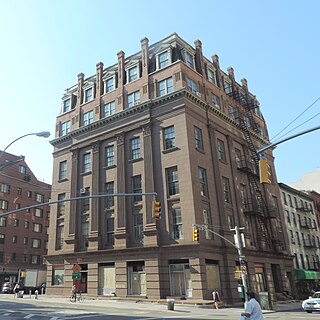
The Odd Fellows Hall is a building at 165–171 Grand Street between Centre and Baxter Streets, in the Little Italy and SoHo neighborhoods of Manhattan, New York City. It was built in 1847–1848 and designed by the firm of Trench & Snook in the Italianate style, one of the city's earliest structures in this style, which Joseph Trench had brought to New York with his design for 280 Broadway in 1845. His partner, John B. Snook, was responsible for many cast-iron buildings in SoHo. The mansard roof was an addition, designed by John Buckingham and built in 1881–1882. The Independent Order of Odd Fellows used the building until the 1880s, when they moved uptown with the city's population. The building was afterwards converted for commercial and industrial use.

51 Market Street, also known as the William and Rosamond Clark House, is a historic house located between Madison and Monroe Streets in lower Manhattan in New York City. The two-story gambrelled house was built in 1824–25 in the late Federal style at a time when the Lower East Side was an affluent residential neighborhood. The original owner was apparently William Clark, a grocer. The upper two stories were added late in the 19th century. The house has been described as a "superb" example of the Federal style.

The Jumel Terrace Historic District is a small New York City and national historic district located in the Washington Heights neighborhood of Manhattan, New York City. It consists of 50 residential rowhouses built between 1890 and 1902, and one apartment building constructed in 1909, as the heirs of Eliza Jumel sold off the land of the former Roger Morris estate. The buildings are primarily wood or brick rowhouses in the Queen Anne, Romanesque and Neo-Renaissance styles. Also located in the district, but separately landmarked, is the Morris-Jumel Mansion, dated to about 1765.
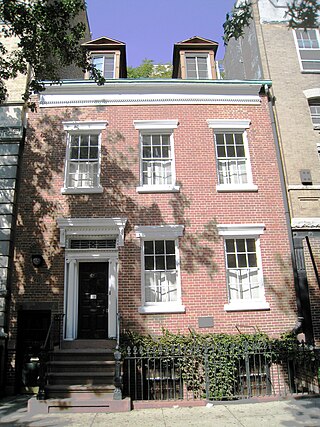
Charles Street is a street in the West Village neighborhood of Manhattan in New York City. It runs east to west from Greenwich Avenue to West Street. The street was named after Charles Christopher Amos, who owned the parcel the street passed through. Amos is also the namesake of Christopher Street, two blocks to the south, and the former Amos Street, which is now West 10th Street. Charles Lane is a one-block alley located between Charles and Perry Streets and Washington and West Streets. From 1866 to 1936, the section of Charles Street between Bleecker Street and West 4th Street was called Van Ness Place after a farm, owned by the Van Ness family, which had occupied the square bounded by Bleecker, West 4th, Charles and Perry Streets until 1865.

























